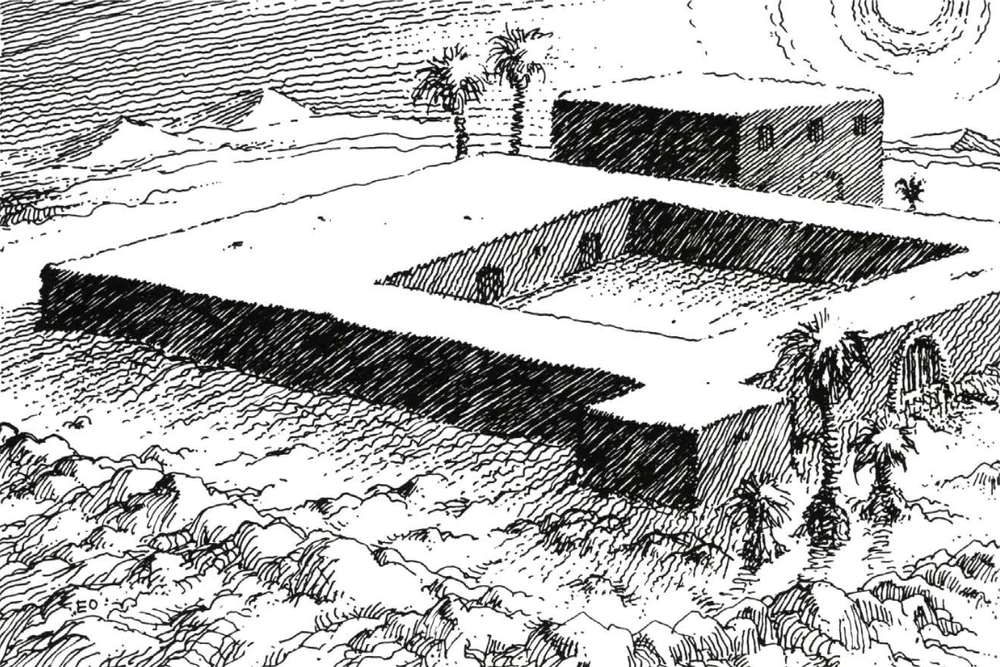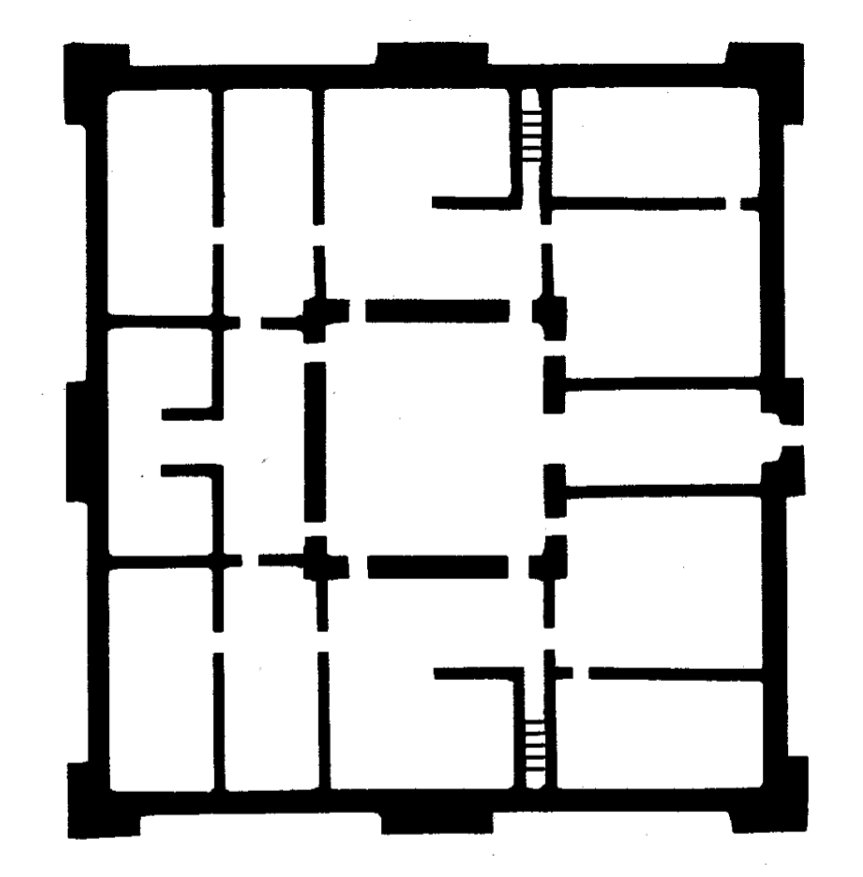Caravanserai
A caravanserai, also called a caravansary in the Hordelands, was a type of a large building found in the southern lands of Faerûn and further south, in the lands of Zakhara. Caravanserais were used for a similar purpose as regular caravan inns.
Contents
- Description
- Locations
- Services
- History
- Notable Carvanserais
Description
Typical Zakharan caravanserais were sturdy square or rectangular structures, similar to small fortresses, with a large central courtyard separated from the outside of the building by a portal1 with one or more portcullis gates.
The gates and the courtyards were big enough to accommodate at least one entire caravan.
The main structure could be as tall as three stories along the trade routes, up to six stories in big cities, and only a single floor when stationed on a less active route.
Outer walls were at least 8 pounds (3.6 kilograms) thick and as strong as those of a keep. They were constructed out of mud-spackled stones or bricks, while upper floors tended to be made out of wood just as often as stone. Caravanserais were never glazed or painted their walls decoratively.
The main managerial office usually was placed above the entrance portal where the owner greeted customers and did business and had a private entrance, often quite secure – an iron-bound door.
Calishite caravanserais were distinct in their design. The structures had at least one minaret and then as many as four, that rose above the rest of the structure. The main gates tended to be taller than their walls but never rose above minarets. These tall, slender towers served as a guide to traveling caravans, letting them know that safety and comfort were within reach. The minarets were usually staffed by watchers and occasionally loudly-preaching priests.
Locations
Caravanserais were built along busy trade routes and served as attended waystations. Most commonly, these buildings could be found in Zakhara, the Land of Fate1 and in the Calim Desert. In major settlements, caravanserais could be found by the main gates.
In the city of Huzuz, caravanserais were a common type of building, with its Caravan District being tightly packed with them, alongside numerous inns, hotels, taverns, and merchant houses. The ancient city of Muluk also offered accommodation within its grand caravanserai, big enough to accommodate six large caravans. The caravansary stood by the grand bazaar across from a slave bazar and offered its guests services of a small mosque, private baths, and a collection of shops. Humble caravanserai could also be found in the city of Kadarasto, while Rog'osto should its visitors with its expansive caravanserai that offered exquisite food and accommodations to all travelers.
A two-story caravanserai once stood outside the town of Starmantle on the Dragon Coast, but was utterly destroyed, along with the city itself with the advent of the Spellplague.
The bridge that stretched atop the Winding Water, part of the Trade Way, had a caravanserai of its own that offered lodgings to traveling merchants.
In the Unapproachable East, caravanserais could be found in the Red Wizard nation of Thay, notably in the tharch of Tyraturos, and the city of Bezantur. The neighboring land of Thesk and its port city of Milvarune had a caravanserai near its east gate.
Caravansary was a commonly-encountered feature in the Hordelands. A town of Uzbeg was itself a large fortified caravansary with a population of 500 in the 15th century DR.Alashan of the Khazari legends held numerous caravansaries, the Ansi Oasis on the border of Shou Lung had a single caravansary, and the Chang-liu-shui Oasis had a caravansary of the hin proprietor Altho Farambler in the 14th century DR.
Services
Similar to regular inns, caravanserais offered meals and lodgings to traveling caravaners, sundries, shelter, and feed for the beasts of burden, as well as secure cargo storage. In the lands where slavery was legal, additional stables and quarters were provided. Fresh water in caravanserais was available from nearby springs, wells, or pumps on the premises. Unlike inns, however, caravanserais often offered other services related to the caravan trade, such as metalsmithing, harness-crafting, cloth and food retail, and of course – entertainment. Long-term leases were also available for interested customers. In Zakhara, such lodgings could be purchased for a sum of 30 to 60 gold pieces. Such apartments were kept clean and ready for the leaser to arrive. They often were purchased by caravaners as second homes. Caravanserais offered safety of travelers' worship and religious ceremonies when on the road.
Most establishments were run by a single family, while other supporting businesses belonged to distant family members and friends of the owner's family.
Calishite caravanserais were known to brew their own ales and wines, using them as an additional incentive to attract passing caravans.
History
The first caravanserais began as nothing more than walled overnight shelters in the wilderness. With time, as the number of caravans grew, caravanserais expanded, taking on more roles to accommodate travelers. In Calimshan, the typical form of caravanserais described above was popularized in the Second Age and had changed little since then. The Fourth and Fifth Ages of the Calim Empire were notable for an architectural quirk of typically clean shapes of caravanserais. During that period of time, it became fashionable to construct additional wings to accommodate especially large and prosperous caravans. Each new wing that was erected was built higher than the one before. However, that practice was abandoned as the Fifth Age came to an end. Unlike in the Lands of Intrigue, most caravanserais in Calimshan were ruined, abandoned, or repurposed into khanduqs, abbeys, monasteries, and schools by the 14th century DR.
Despite caravanserais being mostly forgotten in Calimshan, one notable Calishite caravanserai was found outside the walls of Baldur's Gate. By the late 15th century DR, the caravanserai grew into a walled district of its own – Little Calimshan.
Notable Carvanserais
- Caravanserai of the Red Bull, found in the city of Jumlat, bordering the West Gate Bazaar.
- Delyth Caravanserai, the largest feature of the town of Jiyyd in Narfell.
- Friary of St. Amahl, a Calishite caravanserai along the Trade Way that was converted into an Ilmatari temple by the 14th century DR.
- Golden Bridle, one of caravanserais in Almorel in the 14th century DR.
- House of Wo, a notable establishment in the City of Delights, Huzuz, ran by ajami named Wo in the 14th century DR.
- Leaving-House, a caravanserai and a warehouse in Almorel in the 14th century DR.
- Merchant's Home, a resplendent five-floor tall caravanserai in Huzuz.
- Trader's Rest, one of caravanserais in Almorel in the 14th century DR.
Remove these ads. Join the Worldbuilders Guild










Comments